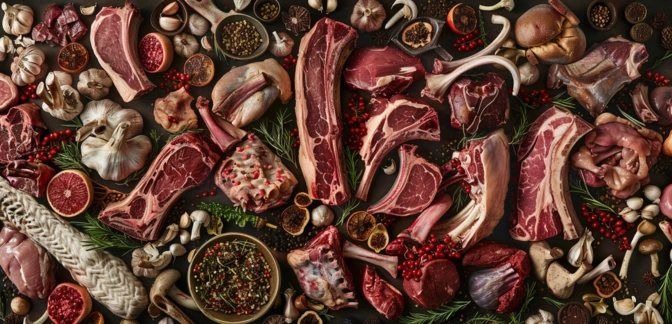Rabbit — Nutrients, Health Benefits, And Shopping Tips

Written by Listonic Team
Last update on September 6, 2024
Rabbit nutrients
Nutrition facts
Amount per 100 g
Calories
🔥 173 kcal
| Nutrients per: 100 g | Value | % Daily Value* |
|---|---|---|
| Carbs | 0 g | - |
| Fiber | 0 g | - |
| Sugars | 0 g | - |
| Glycemic Index | 0 | - |
| Protein | 25 g | 50% |
| Sodium | 44 mg | 1.91% |
| Total Fat | 8 | 10.26% |
*The % of Daily Value (DV) tells you how much a nutrient in a serving of food contributes to a daily diet. 2,000 calories a day is used for general nutrition advice.
25 g
💪 High Protein Content
Rabbit facts & tips
Health benefits
- High in protein, essential for muscle growth, repair, and overall body function.
- Low in fat and cholesterol, making it a heart-healthy option compared to other meats.
- Contains essential vitamins and minerals such as Vitamin B12, Vitamin B3 (niacin), phosphorus, and selenium, which support overall health and well-being.
- Rich in omega-3 fatty acids, which support heart health, reduce inflammation, and improve brain function.
- Supports weight management due to its low calorie and high protein content.
Health risks
- High cholesterol content in rabbit meat, which can be a concern for individuals managing their cholesterol levels when consumed frequently.
- Risk of contamination with harmful bacteria or parasites, particularly if the rabbit is not properly cooked to a safe internal temperature.
- Potential for protein poisoning known as "rabbit starvation," if rabbit is consumed as the sole source of protein over a prolonged period due to its very low fat content.
- Environmental concerns related to the sustainability of rabbit farming and its impact on ecosystems if not managed responsibly.
How to choose rabbit
When selecting rabbit meat, it should be pale pink with a firm texture and minimal fat. The meat should smell fresh and not have any strong gamey odors.
Do not purchase rabbit meat that is dark or has a slimy texture, as these are signs of improper handling or age. Meat that gives off an unpleasant odor should also be avoided, as it is likely not fresh.

How to store rabbit
Fresh rabbit meat should be kept in the refrigerator, securely wrapped in plastic wrap or butcher paper. Store it in the coldest section of the fridge to ensure it remains fresh for 1-2 days. For extended preservation, freezing is advisable.
Exposing rabbit meat to air can cause it to spoil quickly and promote bacterial growth. Refrain from placing it near ready-to-eat items to avoid cross-contamination. Always defrost frozen rabbit in the refrigerator and use it soon after to guarantee optimal flavor and safety.
✅ Extra Tip
How long does it last?
Rabbit can last for 1-2 days in the refrigerator. For longer storage, rabbit can be frozen for up to 6-9 months. Proper packaging, such as vacuum-sealing, helps maintain its quality over longer storage periods.
What to do with leftovers?
Leftover rabbit can be used in a variety of savory dishes. Shred the meat and add it to stews or casseroles for a rich and hearty meal, or mix it into a pasta dish with a creamy sauce. Rabbit is also great when used as a filling for pot pies or turnovers, where its tender meat pairs well with vegetables and gravy.
Use rabbit meat in a risotto with fresh herbs and Parmesan, or mix it into a stir-fry with vegetables and rice. If you have a lot of rabbit, consider making a batch of rabbit rillettes by shredding the meat and mixing it with fat and seasonings, then serving as a spread on toast or crackers. Rabbit can also be used in a quiche or frittata with eggs and cheese, or added to a savory pie with potatoes and root vegetables. For a quick meal, serve rabbit over mashed potatoes or polenta with a rich sauce.
👨⚕️️ Medical disclaimer
How rabbit supports specific health conditions
Rabbit meat is a lean source of high-quality protein, supporting muscle health and aiding in tissue repair. It is also low in fat, making it a heart-healthy option for weight management. Rabbit meat provides important vitamins like B12, supporting brain function and energy metabolism, as well as minerals like phosphorus, promoting bone health. Its delicate flavor makes it a versatile addition to various dishes while providing essential nutrients.
Discover products from other categories
Listonic Team
Fact-checked
Our editorial team checked this article to make sure it was accurate at the time of publishing it.
Get the top-rated shopping list app







